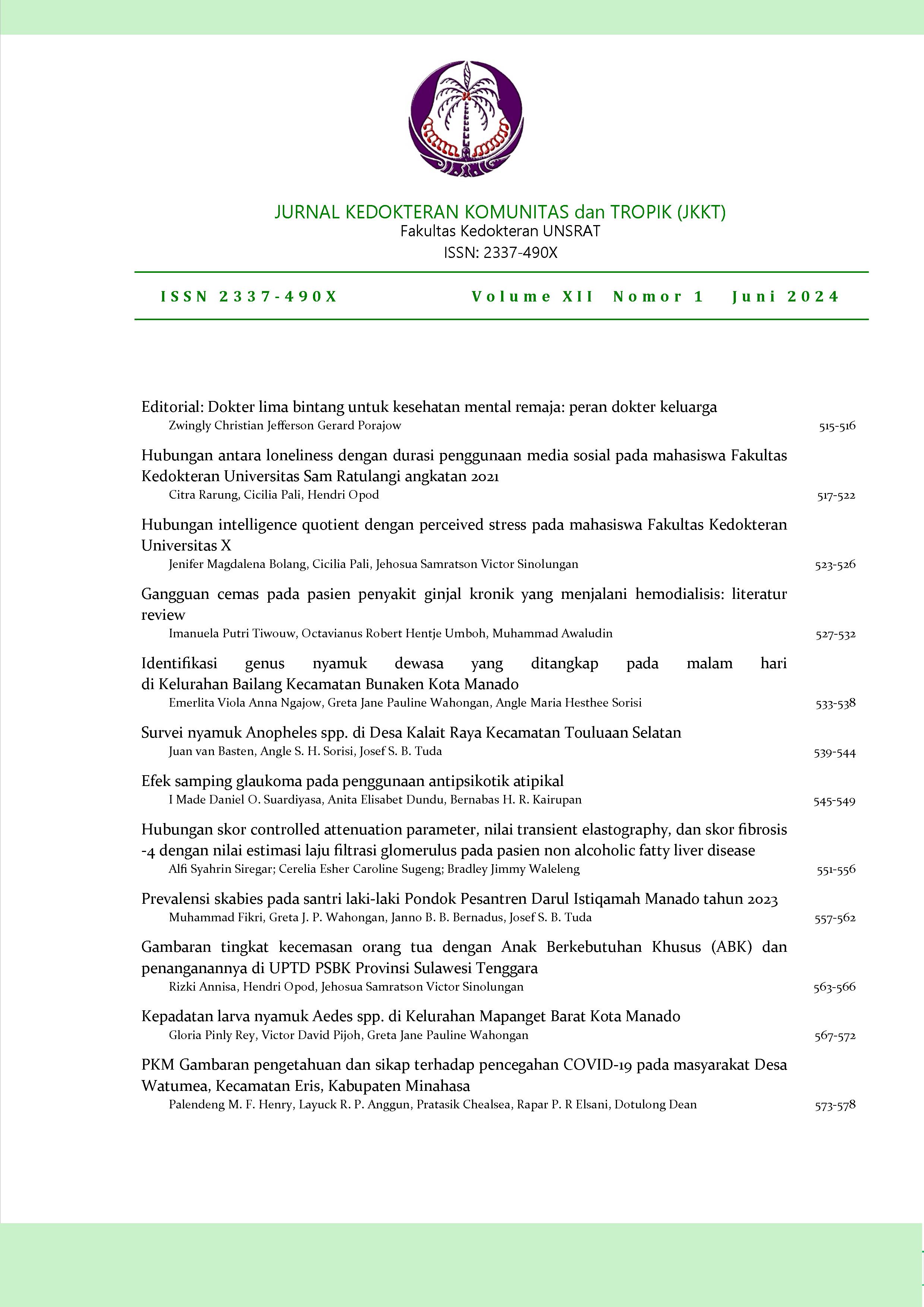Prevalence of scabies among male students at Pondok Pesantren Darul Istiqamah, Manado in 2023
Keywords:
prevalence of scabies, scabies, Sarcoptes scabiei, islamic boarding schoolAbstract
Background: Scabies is a dermatological issue caused by the parasitic mite Sarcoptes scabiei var. hominis. The occurrence of scabies tends to easily spread, both directly through skin-to-skin contact and indirectly through shared objects. Scabies infections commonly occur in individuals residing in communal settings, such as dormitories and boarding schools.
Aim: The aim of this research is to depict the magnitude and prevalence rate among male students at Pondok Pesantren Darul Istiqamah.
Methods: Conducted as a descriptive survey employing the cross-sectional method, this research quantifies the prevalence of scabies among male students at Pondok Pesantren Darul Istiqamah during the period from October to November 2023. The diagnostic process is based on four cardinal signs, with confirmation through laboratory tests.
Results: All male students (75 students) were selected as research subjects based on inclusion criteria. The research findings indicate that 56% or 42 out of 75 sampled students had scabies infections.
Conclusion: The conclusion drawn from this study is that the prevalence of scabies among students at Pondok Pesantren Darul Istiqamah is notably high.
Keywords: prevalence of scabies, scabies, Sarcoptes scabiei, Islamic boarding school
References
Welch E, Romani L, Whitfeld MJ. Recent advances in understanding and treating scabies. Fac Rev. 11 Maret 2021;10.
Siddig EE, Hay R. Laboratory-based diagnosis of scabies: A review of the current status. Vol. 116, Transactions of the Royal Society of Tropical Medicine and Hygiene. Oxford University Press; 2022. hlm. 4–9.
Karimkhani C, Colombara DV, Drucker AM, et al. The global burden of scabies: a cross-sectional analysis from the Global Burden of Disease Study 2015. Lancet Infect Dis. 2017 Dec;17(12):1247-1254. doi: 10.1016/S1473-3099(17)30483-8
World Health Organization Regional Office for the Western Pacific. WHO informal consultation on a framework for scabies control. Manila. 19–21 February 2019.
Al-Dabbagh J, Younis R, Ismail N. The current available diagnostic tools and treatments of scabies and scabies variants: An updated narrative review. Vol. 102, Medicine (United States). Lippincott Williams and Wilkins; 2023.
Departemen Parasitologi FK UI. Parasitologi kedokteran. Edisi Keempat. Balai Penerbit FK UI, Jakarta; 2008.
Chandler DJ, Fuller LC. A review of scabies: an infestation more than skin deep. Dermatology. 2019;235(2):79-90. doi:10.1159/000495290
Sunderkötter C, Wohlrab J, Hamm H. Epidemiologie, diagnostik und therapie der skabies. Dtsch Arztebl Int. 15 Oktober 2021;118(41):695–704.
Yasin Y. Prevalensi skabies dan faktor-faktor yang mempengaruhinya pada siswa-siswi pondok pesantren Tegal Darul Mujadadah Kabupaten Tegal Provinsi Jawa Tengah Bulan Oktober Tahun 2009 [Skripsi]. Jakarta: Fakultas Kedokteran UIN Syarif Hidayatullah. 2009.
Savira TD. Hubungan antara faktor pengetahuan dan perilaku dengan kualitas hidup penderita skabies di Pondok Pesantren Se-Malang Raya [Skripsi]. Malang: Fakultas Kedokteran Dan Ilmu Kesehatan UIN Maulana Malik Ibrahim Malang. 2020.
Tsoi SK, Lake SJ, Thean LJ, et al. Estimation of scabies prevalence using simplified criteria and mapping procedures in three Pacific and southeast Asian countries. BMC Public Health. 2021;21(1):2060. doi:10.1186/s12889-021-12039-2
Puspita SI, Ardiati FN, Adriyani R, Harris N. Faktor kebiasaan menjaga kebersihan perorangan dan gejala skabies di pondok pesantren. Jurnal Promkes. 2021 Sep;9(2):91-100.
Engelman D, Yoshizumi J, Hay RJ, et al. The 2020 International Alliance for the Control of Scabies consensus criteria for the diagnosis of scabies. Br J Dermatol. 2020;183(5):808-20. doi:10.1111/bjd.18943
Siregar RS. Atlas berwarna saripati penyakit kulit. Skabies. Edisi kedua. Jakarta: EGC. 2004.
Avidah A, Krisnarto E, Ratnaningrum K. Faktor risiko skabies di pondok pesantren konvensional dan modern. Herb-Medicine Journal. 2019.
Parman P, Hamdani H, Rachman I, Pratama A. Faktor risiko hygiene perorangan santri terhadap kejadian penyakit kulit skabies di pesantren Al-Baqiyatushshalihat Tanjung Jabung Barat tahun 2017. Jurnal Ilmiah Universitas Batanghari Jambi. 2017;17(3):243-52. Tersedia pada: http://dx.doi.org/10.33087/jiubj.v17i3.418.
Kamal A. Prevalensi kejadian skabies dan analisis faktor-faktor yang mempengaruhinya pada anak di Panti Asuhan An-Nashr Makassar tahun 2019 [skripsi]. Makassar: Universitas Hasanudin. 2019.
Elzatillah E, Surasri S, Mardoyo S. Gambaran kejadian skabies di pondok pesantren tradisional dan pondok pesantren modern. GEMA Lingkungan Kesehatan. 2019;17(1):57-61.
Prabowo M. Hubungan kebersihan diri dan pengetahuan dengan kejadian penyakit skabies di salah satu panti asuhan di Kecamatan Kemiling Kota Bandar Lampung [skripsi]. Bandarlampung: Fakultas Kedokteran Universitas Lampung. 2018.
Ratnasari AF, Sungkar S. Prevalensi skabies dan faktor-faktor yang berhubungan di Pesantren X, Jakarta Timur [skripsi]. Jakarta: Fakultas Kedokteran Indonesia. 2014.
Anggreni PMD, Indira E. Korelasi faktor prediposisi kejadian skabies pada anak-anak di Desa Songan, Kecamatan Kintamani, Kabupaten Bangli, Provinsi Bali. E-Jurnal Medika. 2019; 8(6):4–11. Retrieved from https://ojs.unud.ac.id/index.php/eum/article/download/51740/33047
Downloads
Published
How to Cite
Issue
Section
License
Copyright (c) 2024 Muhammad Fikri, Greta Jane Pauline Wahongan, Janno Berty Bradly Bernadus, Josef Sem Berth Tuda

This work is licensed under a Creative Commons Attribution-NoDerivatives 4.0 International License.


